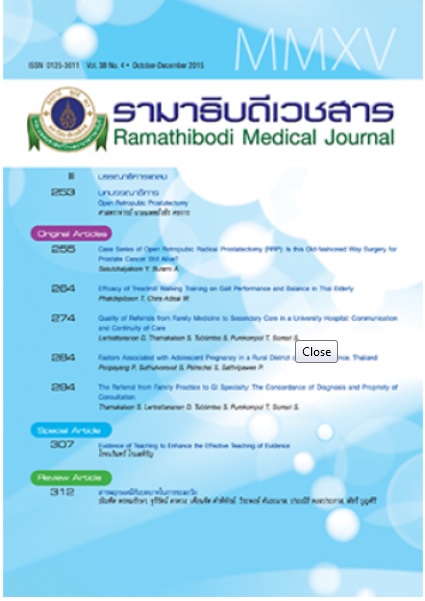Case Series of Open Retropubic Radical Prostatectomy (RRP): Is this Old-fashioned Way Surgery for Prostate Cancer still Alive?
Keywords:
Prostate cancer, Radical retropubic prostatectomy, Open radical prostatectomyAbstract
Introduction: There are increasing number of advanced technology instruments to do prostatectomy in prostate cancer patient, such as Davinci Robot, Advanced laparoscopic instruments (e.g. bipolar vascular sealant, special knotting instruments). The cost of surgery and the availability of these advanced instruments and also surgeon skill are importance factors. RRP is the old open surgery technique for prostate cancer removal that has been blamed for its ineffectiveness about more bleeding, more operative time and longer hospital stay. But anyway, RRP may be a suitable treatment for some rural hospitals which has no advanced instruments or unaffordable patients.
Objective: To evaluate oncological outcome and functional outcome of open radical retropubic prostatectomy performed by a single surgeon’s experience
Material and Methods: 12 patients with localized prostate cancer who underwent Retropubic Radical Prostatectomy were enrolled. Oncological and functional outcomes were evaluated.
Results: Most of the patients (9 out of 12 cases) have no PSA progression and need no further treatment. There was one case of positive surgical margin in all of 12 cases. He refused Radiation so he has received hormonal treatment Another 2 of them had PSA progression, The first case underwent Intensity Modulated Radiation Therapy and 2 years course of hormonal treatment then stopped and he still has no PSA progression. The second patient, He had initial PSA at 58 ng/mL and Gleason’s score at 4+5, has been being received hormonal treatment alone after the PSA nadir did not drop to the level of lower 0.4 ng/mL. All of patients were pad free or had good urinary continence at 1 month after surgery. 7 out of 8 who had active sexual life before surgery, still have good sexual function at 9 months after surgery
Conclusion: Retropubic Radical Prostatectomy may still be an alternative choice of radical prostatectomy for early stage prostate cancer patient with acceptable oncological outcome and good quality of life.
References
Catalona WJ, Han M: Chap 100, Definitive therapy for localized prostate cancer. In: Wein, Kavoussi, Novick, Partin, Peters, eds. Campbell-Walsh Urology, 10th ed, Saunders: 2012:2771-88.
Loeb S, Carter HB. Early Detection, diagnosis, and staging of prostate cancer. In: Wein, Kavoussi, Novick, Partin, Peters, eds. Campbell-Walsh Urology, 10th ed, Saunders: 2012:2763-70.
Schaeffer EM, Walsh PC. Radical Retropubic and perineal prostatectomy. In: Wein, Kavoussi, Novick, Partin, Peters, eds. Campbell-Walsh Urology, 10th ed, Saunders: 2012:2801-28.
Li-Ming Su, Joseph A, Smith Jr. Laparoscopic and Robot-assisted laparoscopic radical prostatectomy and pelvic lymphadenectomy. In: Wein, Kavoussi, Novick, Partin, Peters, eds. Campbell-Walsh Urology, 10th ed, Saunders: 2012:2830-49.
Thomson I. Guideline for the management of clinically localized prostate cancer. American Urological Association, 2011. https://www.auanet.org/education/guidelines/prostate-cancer.cfm
Thomson IM, Valicenti R. Adjuvant and salvage radiotherapy after prostatectomy ASTRO/AUA Guideline. American Urological Association, 2013. https://www.auanet.org/education/guidelines/radiation-after-prostatectomy.cfm
D'Amico AV, Whittington R, Malkowicz SB, et al. Biochemical outcome after radical prostatectomy, external beam radiation therapy, or interstitial radiation therapy for clinically localized prostate cancer. JAMA. 1998;280(11):969-74.
Downloads
How to Cite
Issue
Section
License
Copyright (c) 2015 By the authors. Licensee RMJ, Faculty of Medicine Ramathibodi Hospital, Mahidol University, Bangkok, Thailand

This work is licensed under a Creative Commons Attribution-NonCommercial-NoDerivatives 4.0 International License.













